Experimental Research on Fatigue Behavior of Reinforced UHPC-NC Composite Beams under Cyclic Loading
Abstract
:1. Introduction
2. Bending Tests
2.1. Design of the Test Beam
2.2. Materials
2.3. Manufacturing of Beam
- (1)
- The reinforcing bars would be embedded in the UHPC layer, and all the vertical stirrups of the beam were constructed. The steel formwork was then assembled.
- (2)
- UHPC was poured into the formwork layer by layer until the design thickness of the UHPC layer was reached. The top surface of the UHPC layer was scratched without scraping after vibration in order to maintain the roughness of the top surface of the UHPC layer.
- (3)
- Beams were placed into the curing pool after 6 h of standing. A 72 h steam cure at a temperature of 75 °C was adopted for the beam, as shown in Figure 2.
- (4)
- The reinforcing bars within the NC layer were constructed after the steam-curing of the UHPC layer, and the top surface of the UHPC layer was moistened before casting the NC. Considering all the test beams were prepared and cured in winter at a low ambient temperature, beams were removed from the steel formwork after 500 min of steam-curing at a temperature of 50 °C.
2.4. Experimental Program
3. Results and Discussion
3.1. Fatigue Life of the UHPC-NC Composite Beam
3.2. Interface Performance under Static Loading
3.3. Interface Performance under Cyclic Loading
3.4. Degradation of Bending Stiffness
4. Conclusions
- Compared to the RC beam, the fatigue lives of UHPC-NC composite beams were increased by 4.2 and 7.0 times for the beams with a 200 and 360 mm-thick UHPC layer, respectively.
- The variation of each pair of strains at the interface between UHPC and NC layers kept a similar trend until the beam failed to bend; this indicated the interface performance of the UHPC-NC composite beam barely deteriorated under static loading.
- Under repeated loading, UHPC-NC composite beams showed practically no interfacial cracking and a reduction in interface performance prior to fatigue failure. With a hU/h ratio greater than 40%, the interface between NC and UHPC layers would not be a weakness for the composite beam subjected to cyclic loading.
- The curves of stiffness reduction coefficient for the composite beams could be characterized by three stages: stage I experienced a rapid decrease in less than 10% Nf; stage II kept a steady decrease during about 75~80% Nf; stage III showed another rapid decrease and occupied around 10~15% Nf. Moreover, a calculation method for the stiffness reduction coefficient of UHPC-NC composite beams under cyclic loading was proposed based on the experimental results.
Author Contributions
Funding
Institutional Review Board Statement
Informed Consent Statement
Data Availability Statement
Conflicts of Interest
References
- Shiotani, T.; Ohtsu, H.; Momoki, S.; Chai, H.K.; Onishi, H.; Kamada, T. Damage evaluation for concrete bridge deck by means of stress wave techniques. J. Bridge Eng. 2012, 17, 847–856. [Google Scholar] [CrossRef]
- Stein, K.J.; Graeff, Â.G.; Garcez, M.R. Structural performance of reinforced concrete beams subjected to combined effects of corrosion and cyclic loading. J. Build. Pathol. Rehabil. 2023, 8, 15. [Google Scholar] [CrossRef]
- Al-Hammoud, R.; Soudki, K.; Topper, T.H. Bond analysis of corroded reinforced concrete beams under monotonic and fatigue loads. Cem. Concr. Compos. 2010, 32, 194–203. [Google Scholar] [CrossRef]
- Bayane, I.; Mankar, A.; Brühwiler, E.; Sørensen, J.D. Quantification of traffic and temperature effects on the fatigue safety of a reinforced-concrete bridge deck based on monitoring data. Eng. Struct. 2019, 196, 109357. [Google Scholar] [CrossRef]
- Nam, B.H. In-situ super accelerated pavement test for the fatigue evaluation of in-service airfield rigid pavement—A case study at Mecham Airport. Constr. Build. Mater. 2022, 353, 129115. [Google Scholar] [CrossRef]
- Li, D.; Kaewunruen, S.; You, R.; Liu, P. Fatigue life modelling of railway prestressed concrete sleepers. Structures 2022, 41, 643–656. [Google Scholar] [CrossRef]
- Shahid, K.A.; Bunnori, N.M.; Johari, M.A.; Hassan, M.H.; Sani, A. Assessment of corroded reinforced concrete beams: Cyclic load test and acoustic emission techniques. Constr. Build. Mater. 2020, 233, 117291. [Google Scholar] [CrossRef]
- Bayane, I.; Pai, S.G.S.; Smith, I.F.; Brühwiler, E. Model-based interpretation of measurements for fatigue evaluation of existing reinforced concrete bridges. J. Bridge Eng. 2021, 26, 04021054. [Google Scholar] [CrossRef]
- Manibalan, P.; Kesavan, S.; Abirami, G.; Baskar, R. Fatigue response of RC beam strengthened by BFRP laminate. Case Stud. Constr. Mater. 2023, 18, e01707. [Google Scholar] [CrossRef]
- Chinnasamy, Y.; Joanna, P.S.; Kothanda, K.; Gurupatham, B.G.A.; Roy, K. Behavior of pultruded glass-fiber-reinforced polymer beam-columns infilled with engineered cementitious composites under cyclic loading. J. Compos. Sci. 2022, 6, 338. [Google Scholar] [CrossRef]
- Graybeal, B.; Brühwiler, E.; Kim, B.S.; Kim, B.S.; Toutlemonde, F.; Voo, Y.L.; Zaghi, A. International perspective on UHPC in bridge engineering. J. Bridge Eng. 2020, 25, 04020094. [Google Scholar] [CrossRef]
- Bahmani, H.; Mostofinejad, D. Microstructure of ultra-high-performance concrete (UHPC)—A review study. J. Build. Eng. 2022, 50, 104118. [Google Scholar] [CrossRef]
- Arora, A.; Almujaddidi, A.; Kianmofrad, F.; Mobasher, B.; Neithalath, N. Material design of economical ultra-high performance concrete (UHPC) and evaluation of their properties. Cem. Concr. Compos. 2019, 104, 103346. [Google Scholar] [CrossRef]
- Alsalman, A.; Dang, C.N.; Martí-Vargas, J.R.; Hale, W.M. Mixture-proportioning of economical UHPC mixtures. J. Build. Eng. 2020, 27, 100970. [Google Scholar] [CrossRef]
- Bertola, N.; Schiltz, P.; Denarié, E.; Brühwiler, E. A review of the use of UHPFRC in bridge rehabilitation and new construction in Switzerland. Front. Built Environ. 2021, 7, 769686. [Google Scholar] [CrossRef]
- Brühwiler, E.; Denarié, E. Rehabilitation and strengthening of concrete structures using ultra-high performance fibre reinforced concrete. Struct. Eng. Int. 2013, 23, 450–457. [Google Scholar] [CrossRef]
- Farzad, M.; Shafieifar, M.; Azizinamini, A. Retrofitting of bridge columns using UHPC. J. Bridge Eng. 2019, 24, 04019121. [Google Scholar] [CrossRef]
- Aboukifa, M.; Moustafa, M.A. Structural and buckling behavior of full-scale slender UHPC columns. Eng. Struct. 2022, 255, 113928. [Google Scholar] [CrossRef]
- Kadhim, M.M.A.; Jawdhari, A.; Peiris, A. Development of hybrid UHPC-NC beams: A numerical study. Eng. Struct. 2021, 233, 111893. [Google Scholar] [CrossRef]
- Zhang, Y.; Yang, Z.; Xie, T.; Yang, J. Flexural behaviour and cost effectiveness of layered UHPC-NC composite beams. Eng. Struct. 2022, 273, 115060. [Google Scholar] [CrossRef]
- Li, S.; Zhang, L.; Guo, P.; Zhang, P.; Wang, C.; Sun, W.; Han, S. Characteristic analysis of acoustic emission monitoring parameters for crack propagation in UHPC-NC composite beam under bending test. Constr. Build. Mater. 2021, 278, 122401. [Google Scholar] [CrossRef]
- Lin, P.; Yan, W.; Zhao, H.; Ma, J. Theoretical and experimental investigation on the flexural behaviour of prestressed NC-UHPC composite beams. Materials 2023, 16, 879. [Google Scholar] [CrossRef]
- Ascione, L.; Feo, L. Modeling of composite/concrete interface of RC beams strengthened with composite laminates. Compos. Part B Eng. 2000, 31, 535–540. [Google Scholar] [CrossRef]
- Hag-Elsafi, O.; Alampalli, S.; Kunin, J. Application of FRP laminates for strengthening of a reinforced-concrete T-beam bridge structure. Compos. Struct. 2001, 52, 453–466. [Google Scholar] [CrossRef]
- Haroon, M.; Moon, J.S.; Kim, C. Performance of reinforced concrete beams strengthened with carbon fiber reinforced polymer strips. Materials 2021, 14, 5866. [Google Scholar] [CrossRef]
- Aykac, S.; Kalkan, I.; Aykac, B.; Karahan, S.; Kayar, S. Strengthening and repair of reinforced concrete beams using external steel plates. J. Struct. Eng. 2013, 139, 929–939. [Google Scholar] [CrossRef]
- Tong, T.; Yuan, S.; Wang, J.; Liu, Z. The role of bond strength in structural behaviors of UHPC-NC composite beams: Experimental investigation and finite element modeling. Compos. Struct. 2021, 255, 112914. [Google Scholar] [CrossRef]
- Harris, D.; Muñoz, M.C.; Gheitasi, A.; Ahlborn, T.M.; Rush, S.V. The challenges related to interface bond characterization of ultra-high-performance concrete with implications for bridge rehabilitation practices. Adv. Civ. Eng. Mater. 2015, 4, 75–101. [Google Scholar] [CrossRef]
- Zhao, Y.C.; Lei, H.G.; Guo, L.K.; Lu, G.Y. Experimental Investigation on Interface Performance of UHPC-Strengthened NC Structure through Push-Out Tests. Materials 2023, 16, 1766. [Google Scholar] [CrossRef]
- Wu, X.G.; Han, S.M. Interface shear connection analysis of ultrahigh-performance fiber-reinforced concrete composite girders. J. Bridge Eng. 2010, 15, 493–502. [Google Scholar] [CrossRef]
- Habel, K.; Denarié, E.; Brühwiler, E. Experimental investigation of composite ultra-high-performance fiber-reinforced concrete and conventional concrete members. ACI Struct. J. 2007, 104, 93. [Google Scholar]
- Paschalis, S.A.; Lampropoulos, A.P.; Tsioulou, O. Experimental and numerical study of the performance of ultra high performance fiber reinforced concrete for the flexural strengthening of full scale reinforced concrete members. Constr. Build. Mater. 2018, 186, 351–366. [Google Scholar] [CrossRef]
- Yin, H.; Teo, W.; Shirai, K. Experimental investigation on the behaviour of reinforced concrete slabs strengthened with ultra-high performance concrete. Constr. Build. Mater. 2017, 155, 463–474. [Google Scholar] [CrossRef]
- Al-Osta, M.A.; Isa, M.N.; Baluch, M.H.; Rahman, M.K. Flexural behavior of reinforced concrete beams strengthened with ultra-high performance fiber reinforced concrete. Constr. Build. Mater. 2017, 134, 279–296. [Google Scholar] [CrossRef]
- Balaguru, P.N. Analysis of prestressed concrete beams for fatigue loading. PCI J. 1981, 26, 70–94. [Google Scholar] [CrossRef]
- Nor, N.M.; Ibrahim, A.; Bunnori, N.M.; Saman, H.M. Acoustic emission signal for fatigue crack classification on reinforced concrete beam. Constr. Build. Mater. 2013, 49, 583–590. [Google Scholar] [CrossRef]
- Ferrier, E.; Michel, L. Experimental and analytical study of fatigue behaviour of Reinforced UHPC beams. In Proceedings of the 2nd International Interactive Symposium on Ultra-High Performance Concrete, Albany, NY, USA, 2–5 June 2019; Iowa State University Digital Press: Ames, IA, USA, 2019; p. 2. [Google Scholar]
- Sawicki, B.; Brühwiler, E. Fatigue resistance of reinforced UHPFRC beams. Int. J. Fatigue 2021, 148, 106216. [Google Scholar] [CrossRef]
- Ríos, J.D.; Cifuentes, H.; Blasón, S.; López-Aenlle, M.; Martínez-De La Concha, A. Flexural fatigue behaviour of a heated ultra-high-performance fibre-reinforced concrete. Constr. Build. Mater. 2021, 276, 122209. [Google Scholar] [CrossRef]
- Makita, T.; Brühwiler, E. Fatigue behaviour of bridge deck slab elements strengthened with reinforced UHPFRC. In Proceedings of the IABMAS Bridge Maintenance, Safety, Management, Resilience and Sustainability, Stresa, Italy, 9–11 July 2012; pp. 1974–1980. [Google Scholar]
- Al-Azzawi, B. Fatigue of Reinforced Concrete Beams Retrofitted with Ultra-High Performance Fibre-Reinforced Concrete. Ph.D. Thesis, Cradiff University, Cardiff, UK, 2018. [Google Scholar]
- Murthy, A.R.; Karihaloo, B.L.; Rani, P.V.; Priya, D.S. Fatigue behaviour of damaged RC beams Strengthened with Ultra high performance fibre Reinforced Concrete. Int. J. Fatigue 2018, 116, 659–668. [Google Scholar] [CrossRef]
- Li, A.; Yang, Z.; Liu, S.; Liu, Y.; Liu, H. Experimental study on flexural fatigue behavior of composite T-beams in ultra-high performance concrete reinforced and normal-strength concrete. Int. J. Fatigue 2023, 167, 107330. [Google Scholar] [CrossRef]
- Ganesh, P.; Murthy, A.R. Flexural fatigue strains of constituent materials in strengthened RC beams with UHPC strips. Int. J. Fatigue 2023, 167, 107351. [Google Scholar] [CrossRef]
- Li, P.P.; Yu, Q.L.; Brouwers, H.J.H. Effect of coarse basalt aggregates on the properties of Ultra-high Performance Concrete (UHPC). Constr. Build. Mater. 2018, 170, 649–659. [Google Scholar] [CrossRef]
- Zhang, J.; Li, V.C. Monotonic and fatigue performance in bending of fiber-reinforced engineered cementitious composite in overlay system. Cem. Concr. Res. 2002, 32, 415–423. [Google Scholar] [CrossRef]
- Hu, T.M.; Huang, C.K.; Chen, X.F. Fatigue properties of special kind of reinforced concrete composite beams. J. Cent. South Univ. Technol. 2010, 17, 142–149. [Google Scholar] [CrossRef]
- Guo, M.L. Experimental and Theoretical Study on Static Mechanical Performance of RPC-NC Composite Beam. Ph.D. Thesis, Beijing Jiaotong University, Beijing, China, 2018. [Google Scholar]
- Li, W.W.; Ji, W.Y.; An, M.Z.; Zhu, L.; Wang, J. Flexural performance of composite prestressed UHPC-NC T-girders. J. Bridge Eng. 2020, 25, 04020064. [Google Scholar] [CrossRef]
- Wang, J.; Ji, W.; An, M.; Li, W. Fatigue behavior of reinforced UHPC-NC composite beams. Case Stud. Constr. Mater. 2023, 18, e02055. [Google Scholar] [CrossRef]
- Luo, X.Y.; Chen, Y.Y.K.; Deng, P.Q. Experimental study on fatigue properties of unbounded partially prestressed concrete (UPC) beams. J. Build. Struct. 2007, 28, 98–104. [Google Scholar]

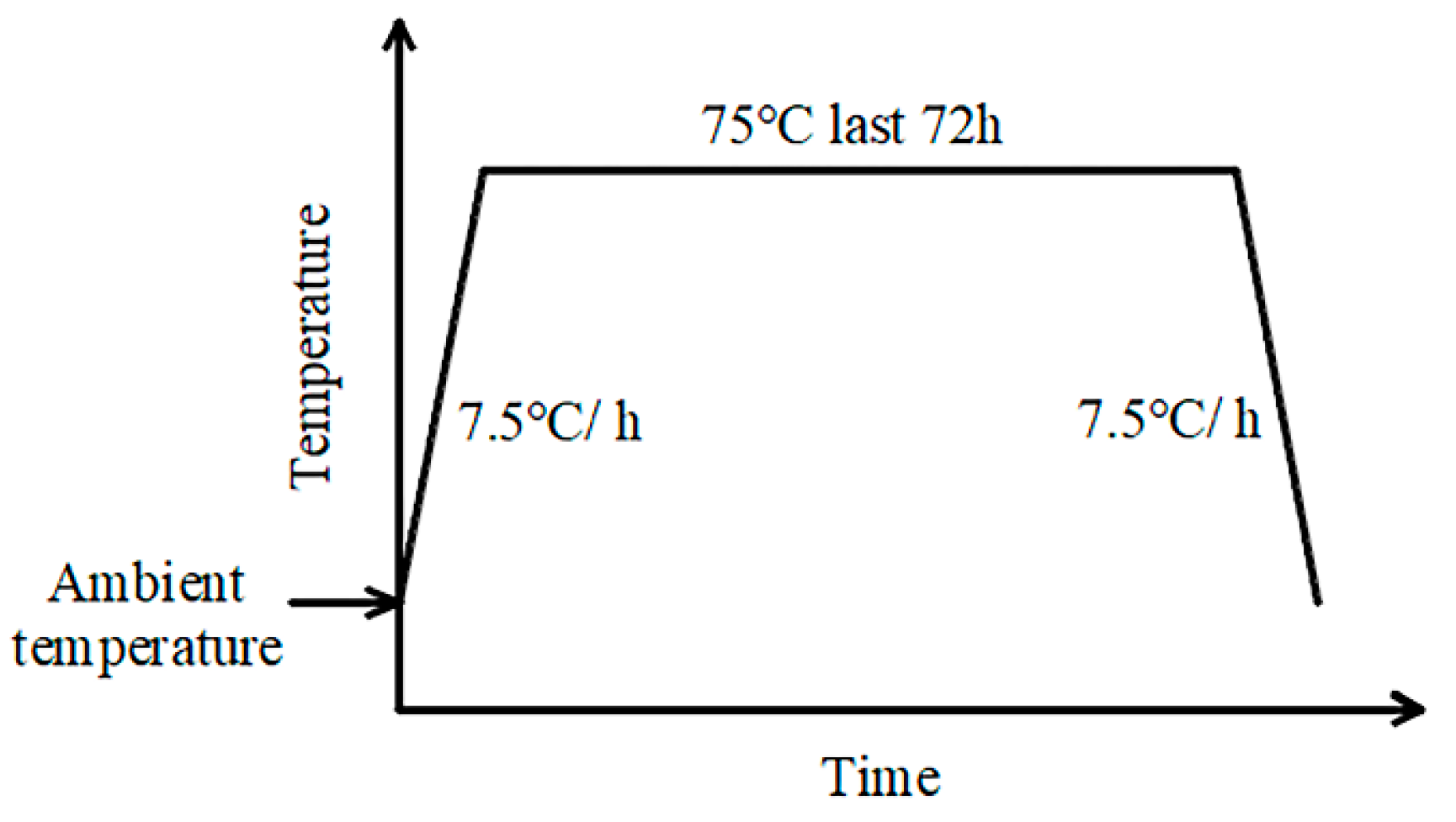

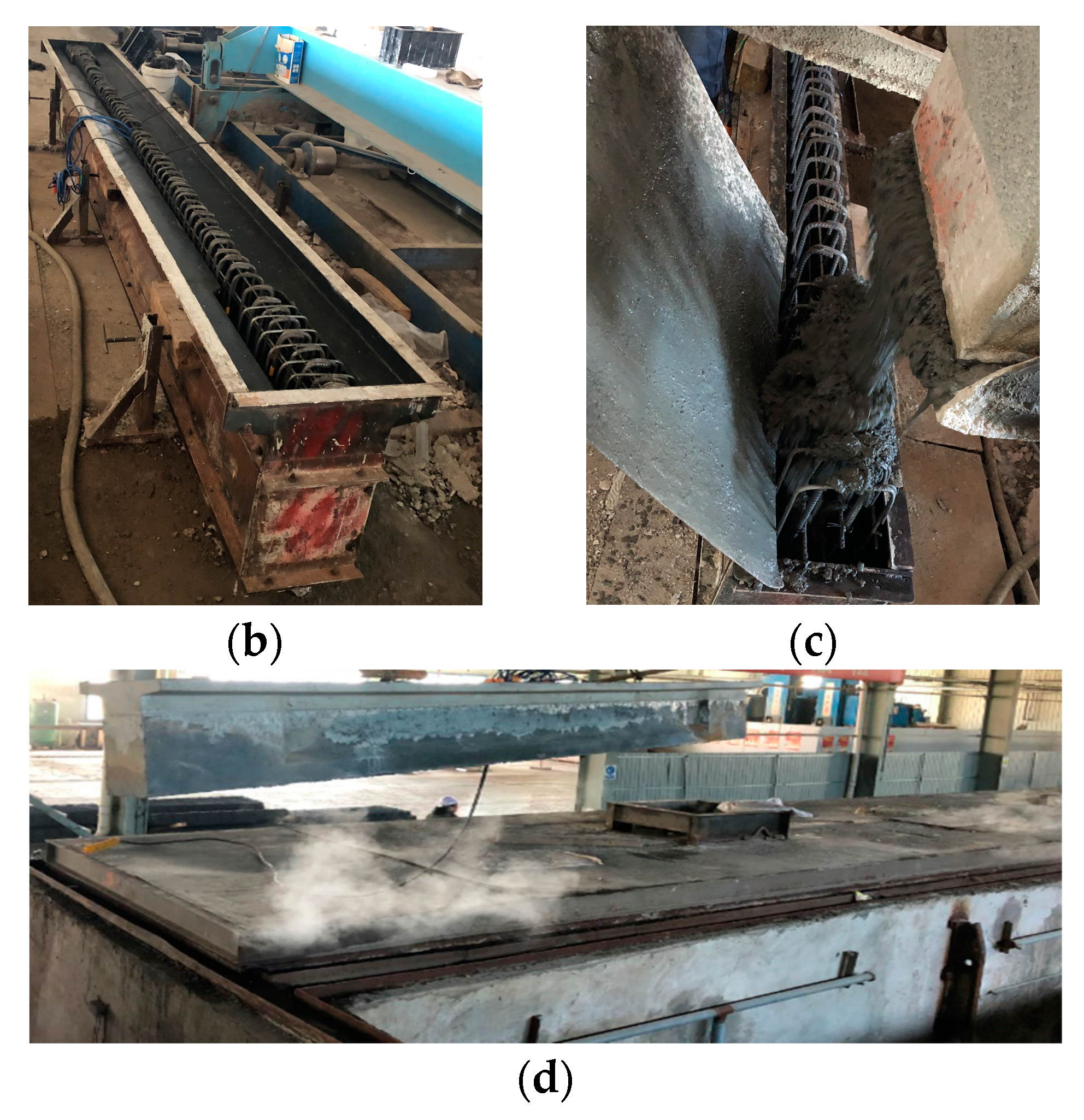
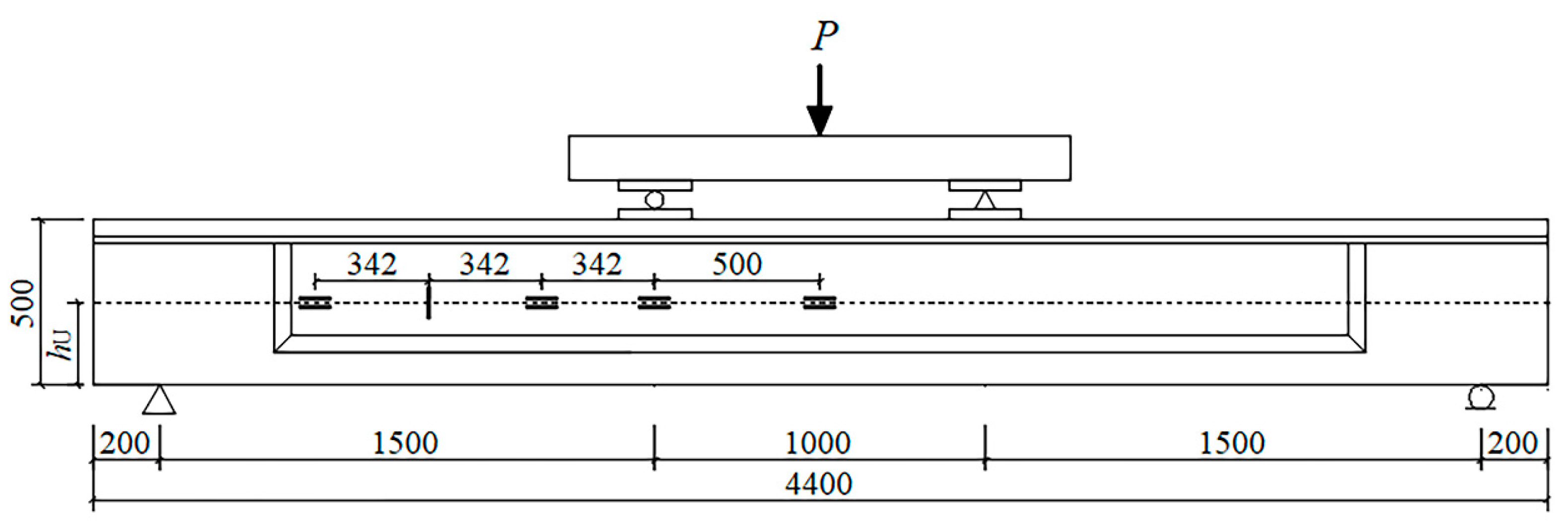
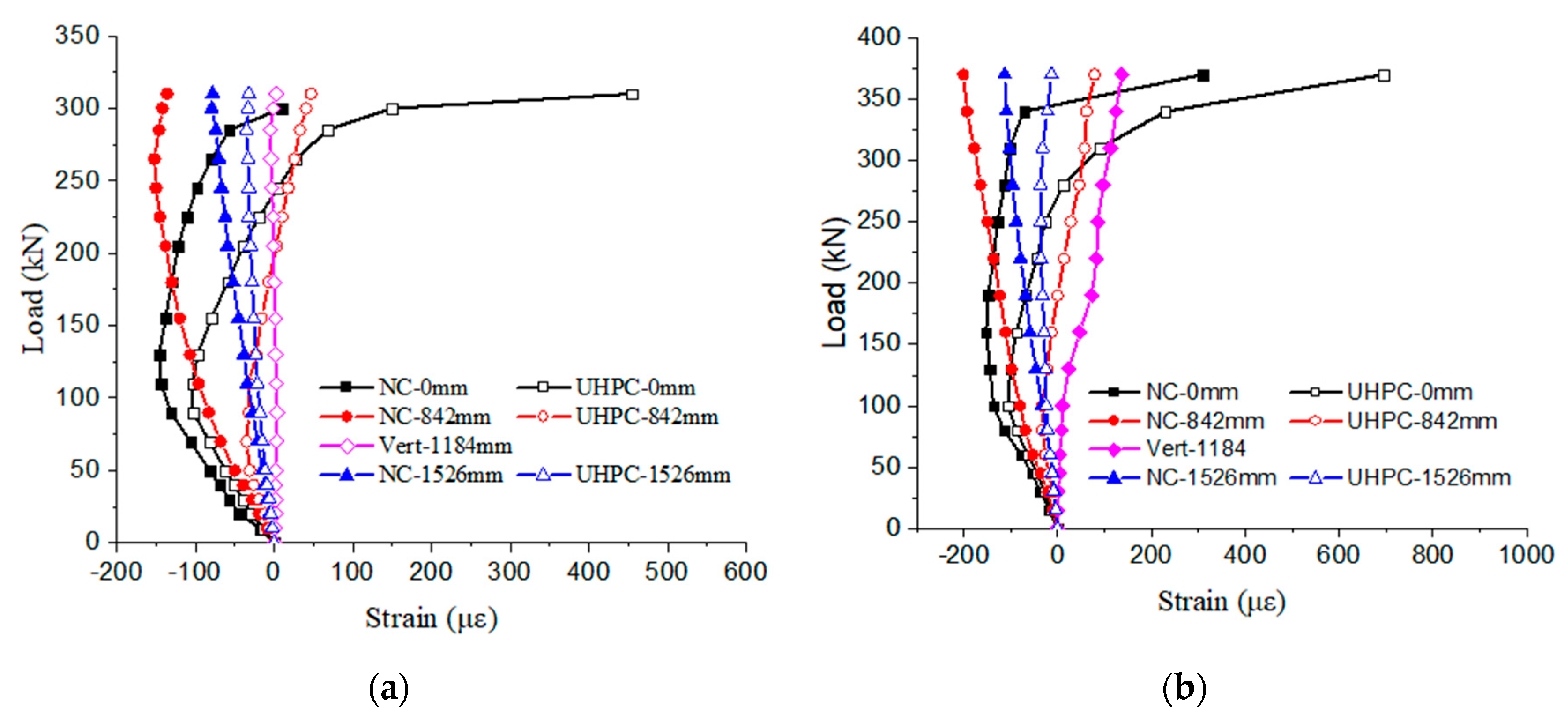
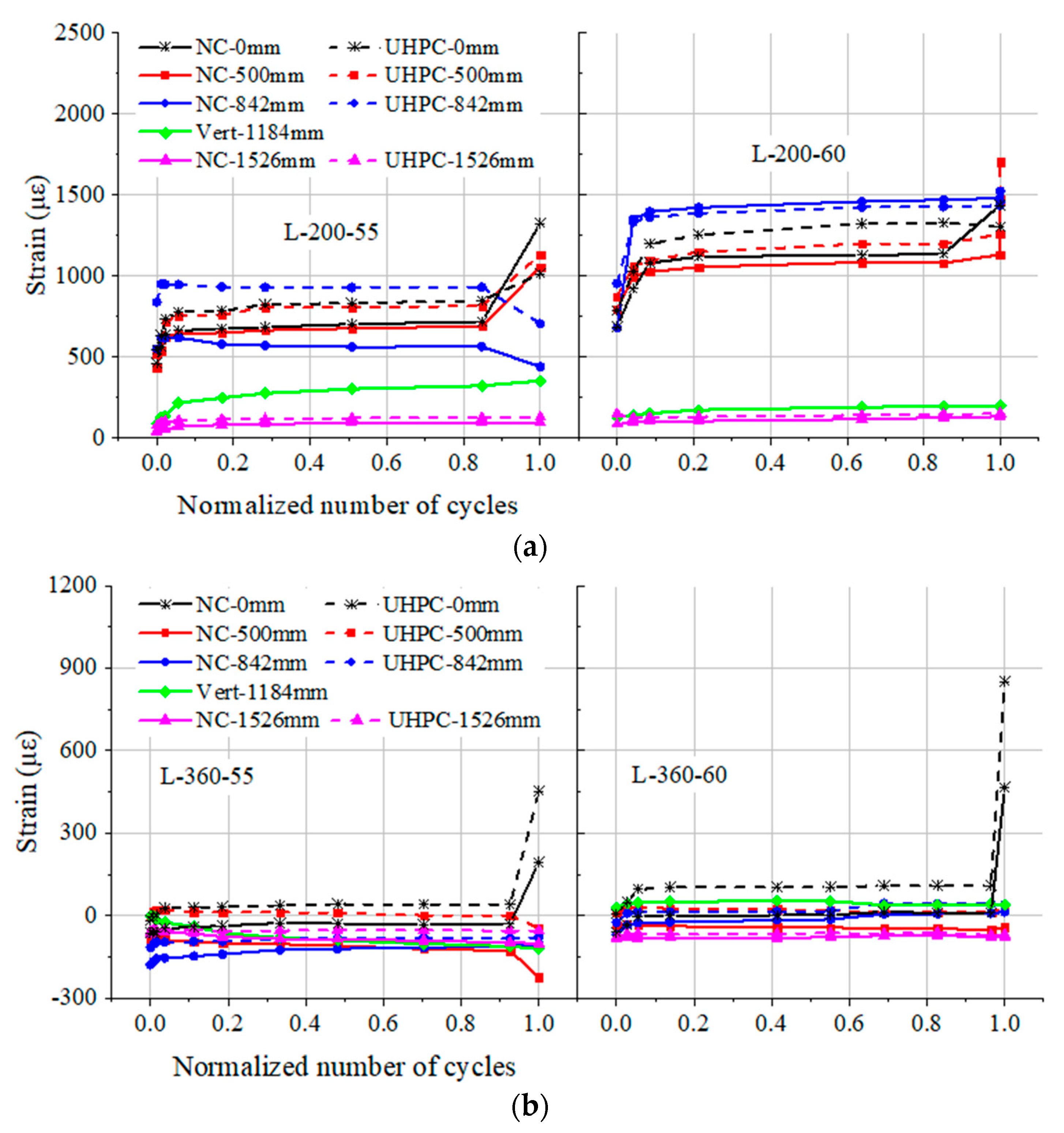
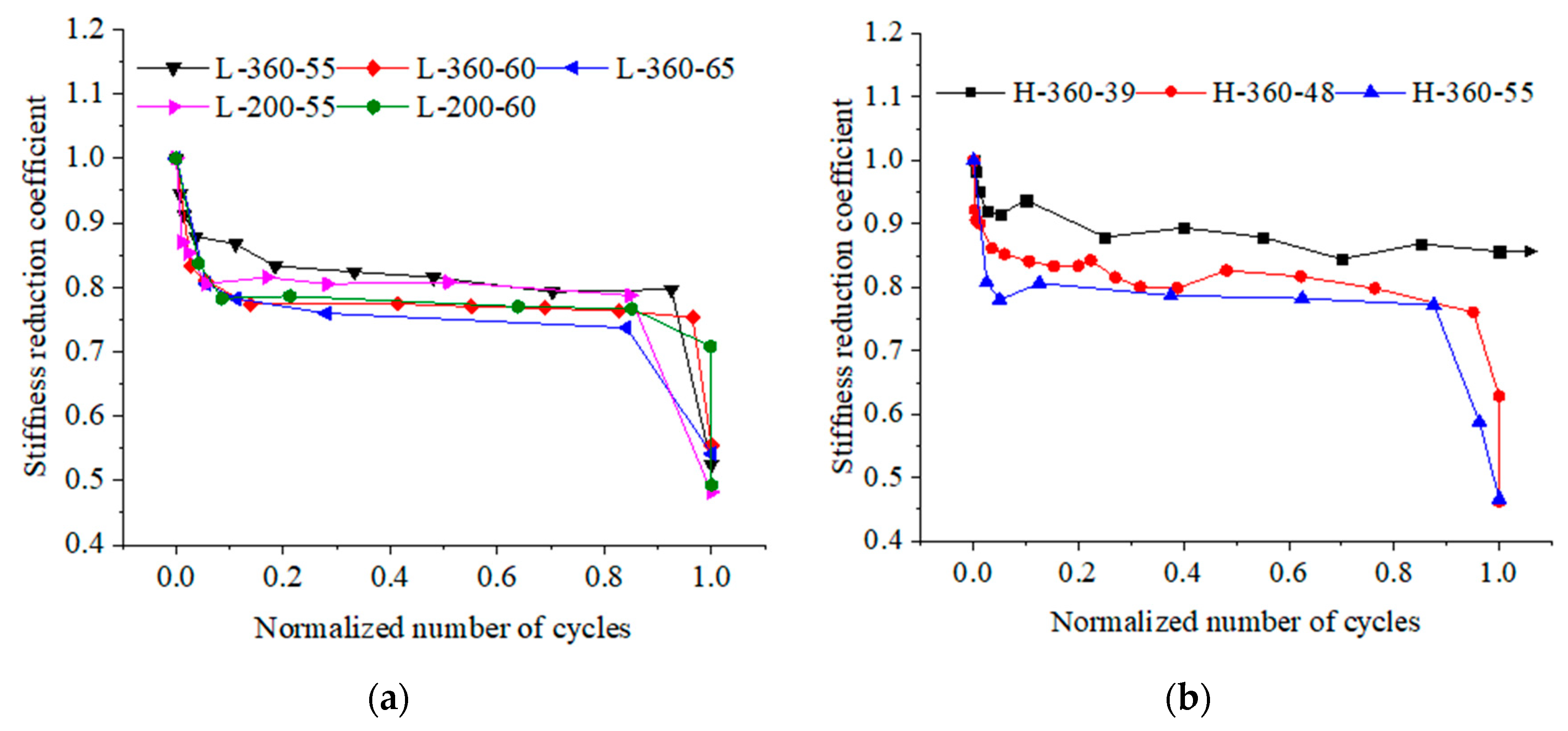

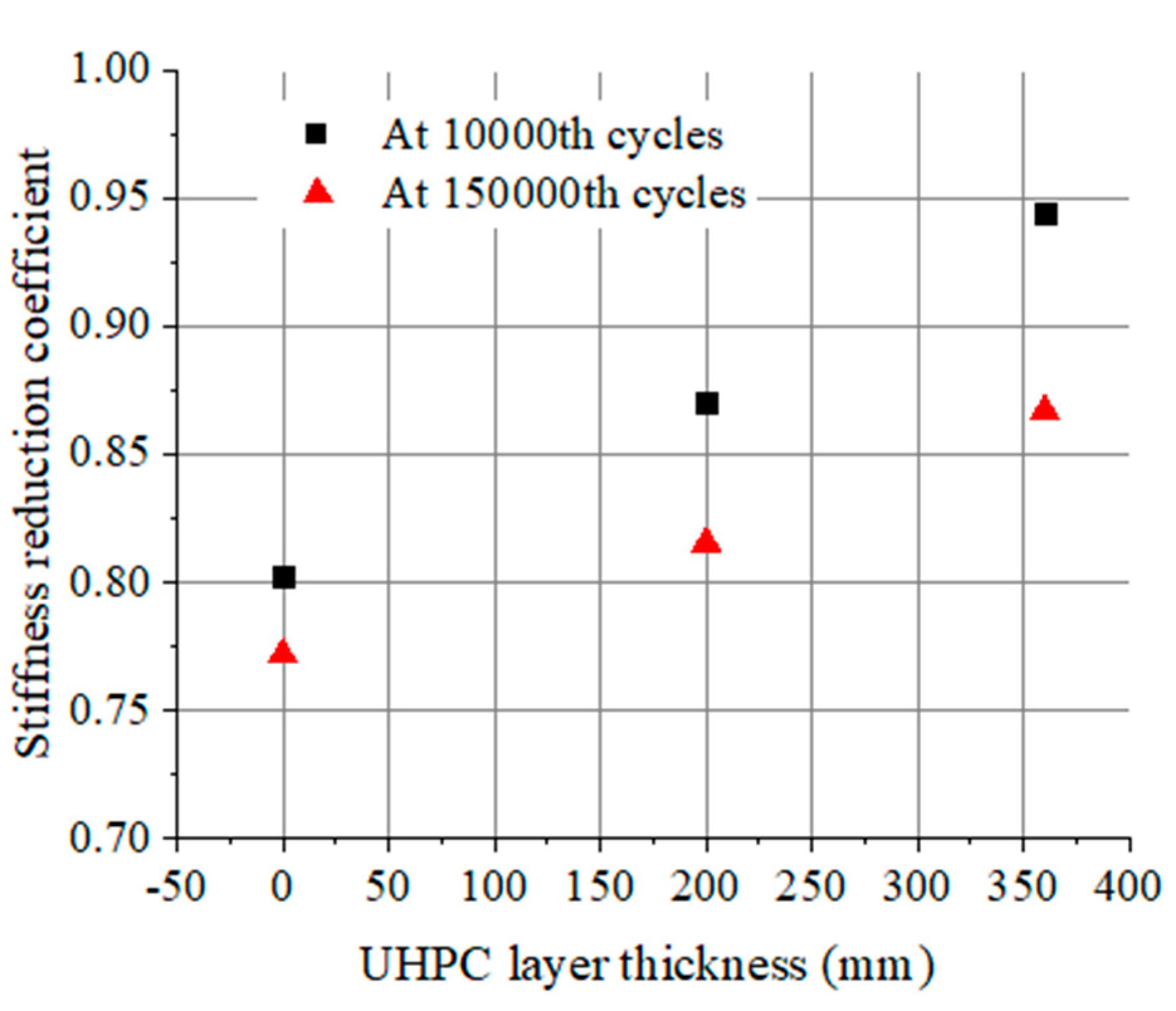
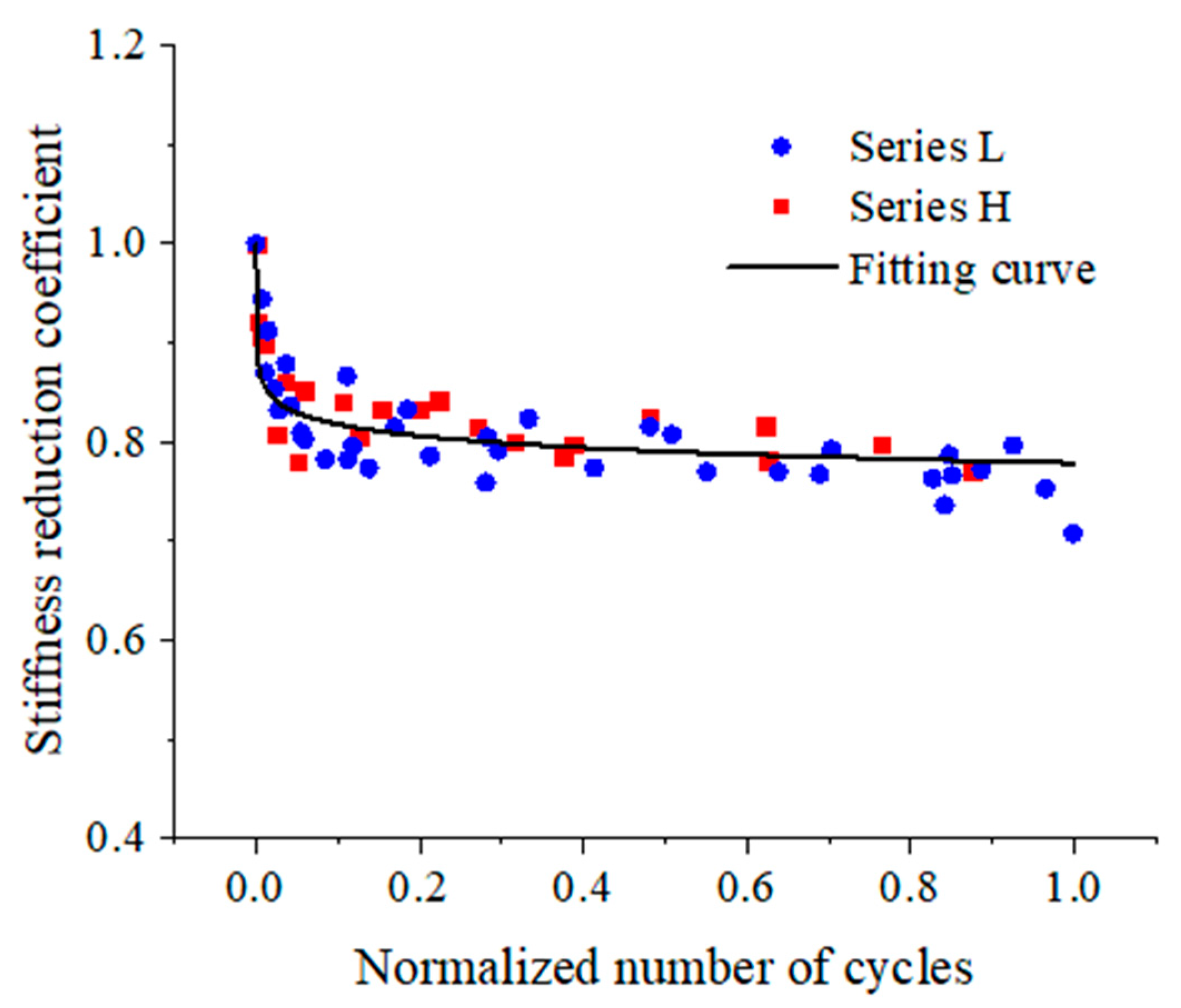
| Test Series | Beam Designation | UHPC Layer Thickness (hU)/mm | Reinforcement Ratio (ρs)/% |
|---|---|---|---|
| Series S | L-360-S | 360 | 1.184 |
| H-360-S | 360 | 1.786 | |
| Series L | L-0-55 | 0 | 1.184 |
| L-200-55 | 200 | 1.184 | |
| L-200-60 | 200 | 1.184 | |
| L-360-55 | 360 | 1.184 | |
| L-360-60 | 360 | 1.184 | |
| L-360-65 | 360 | 1.184 | |
| Series H | H-360-39 | 360 | 1.786 |
| H-360-48 | 360 | 1.786 | |
| H-360-55 | 360 | 1.786 |
| UHPC | Cement | Silica fume | Quartz sand | Crushed stone | Water | Superplasticizer | Steel fiber |
| 1.00 | 0.285 | 1.258 | 0.877 | 0.256 | 0.006 | 0.192 | |
| NC | Cement | Mineral powder | River sands | Crushed stone | Water | Superplasticizer | |
| 1.00 | 0.098 | 1.719 | 2.613 | 0.336 | 0.013 |
| Type | Average Length (mm) | Diameter (mm) | Aspect Ratio | Ultimate Tensile Strength (MPa) |
|---|---|---|---|---|
| Copper-coated steel fiber | 13 | 0.2 | 65 | 2860 |
| Material | NC | UHPC | ||||
|---|---|---|---|---|---|---|
| Beam | Compressive Strength (MPa) | Flexural Tensile Strength (MPa) | Elastic Modulus (GPa) | Compressive Strength (MPa) | Flexural Tensile Strength (MPa) | Elastic Modulus (GPa) |
| L-360-S | 62.24 | 6.52 | 37.23 | 138.80 | 15.11 | 45.57 |
| H-360-S | 58.96 | 6.86 | 37.92 | 128.41 | 14.36 | 45.26 |
| L-0-55 | 59.12 | 6.61 | 37.00 | - | - | - |
| L-200-55 | 60.10 | 6.65 | 35.57 | 134.07 | 14.51 | 46.46 |
| L-200-60 | 60.10 | 6.65 | 35.57 | 134.07 | 14.51 | 46.46 |
| L-360-55 | 64.85 | 6.70 | 38.26 | 130.48 | 14.21 | 44.07 |
| L-360-60 | 64.85 | 6.70 | 38.26 | 130.48 | 14.21 | 44.07 |
| L-360-65 | 62.24 | 6.52 | 37.23 | 138.80 | 15.11 | 45.57 |
| H-360-39 | 57.49 | 6.58 | 37.53 | 129.63 | 14.67 | 43.38 |
| H-360-48 | 57.49 | 6.58 | 37.53 | 129.63 | 14.67 | 43.38 |
| H-360-55 | 58.96 | 6.86 | 37.92 | 128.41 | 14.36 | 45.26 |
| Diameter (mm) | Yield Strength (MPa) | Ultimate Strength (MPa) | Modulus of Elasticity (GPa) |
|---|---|---|---|
| 12 | 449 | 607 | 201 |
| 14 | 455 | 627 | 200 |
| 16 | 456 | 616 | 200 |
| 20 | 441 | 615 | 201 |
| Beam Designation | Pmax 1 | Pmin 2 | Frequency (Hz) | Nf |
|---|---|---|---|---|
| L-0-55 | 0.55 | 0.08 | 4.0 | 169,235 |
| L-200-55 | 0.55 | 0.08 | 4.0 | 884,707 |
| L-200-60 | 0.60 | 0.08 | 3.0 | 234,917 |
| L-360-55 | 0.55 | 0.08 | 4.0 | 1,350,708 |
| L-360-60 | 0.60 | 0.08 | 3.0 | 362,802 |
| L-360-65 | 0.65 | 0.08 | 2.0 | 178,241 |
| H-360-39 | 0.39 | 0.16 | 4.0 | 2,000,000 3 |
| H-360-48 | 0.48 | 0.07 | 3.0 | 4,258,667 |
| H-360-55 | 0.55 | 0.08 | 2.0 | 399,698 |
Disclaimer/Publisher’s Note: The statements, opinions and data contained in all publications are solely those of the individual author(s) and contributor(s) and not of MDPI and/or the editor(s). MDPI and/or the editor(s) disclaim responsibility for any injury to people or property resulting from any ideas, methods, instructions or products referred to in the content. |
© 2024 by the authors. Licensee MDPI, Basel, Switzerland. This article is an open access article distributed under the terms and conditions of the Creative Commons Attribution (CC BY) license (https://creativecommons.org/licenses/by/4.0/).
Share and Cite
Wang, J.; Ji, W.; Li, W.; Zhao, T. Experimental Research on Fatigue Behavior of Reinforced UHPC-NC Composite Beams under Cyclic Loading. Materials 2024, 17, 747. https://doi.org/10.3390/ma17030747
Wang J, Ji W, Li W, Zhao T. Experimental Research on Fatigue Behavior of Reinforced UHPC-NC Composite Beams under Cyclic Loading. Materials. 2024; 17(3):747. https://doi.org/10.3390/ma17030747
Chicago/Turabian StyleWang, Jue, Wenyu Ji, Wangwang Li, and Tibo Zhao. 2024. "Experimental Research on Fatigue Behavior of Reinforced UHPC-NC Composite Beams under Cyclic Loading" Materials 17, no. 3: 747. https://doi.org/10.3390/ma17030747





